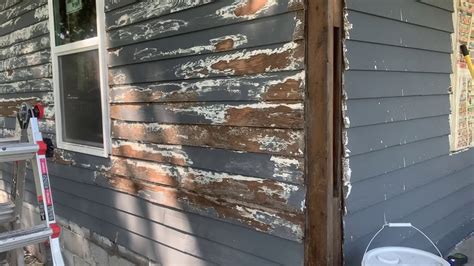Embark on a journey to transform your home with a fresh coat of exterior paint. Discover the secrets behind boosting curb appeal, protecting your home from the elements, and expressing your unique style through color selection.
Explore the nuances of choosing the right paint, preparing surfaces like a pro, mastering painting techniques, and ensuring a flawless finish that will leave your home looking brand new.


Importance of Exterior Home Painting
Painting the exterior of a home is crucial for both aesthetic and practical reasons. It not only enhances the overall look of the house but also provides protection against various elements.Enhancing Curb Appeal
Exterior paint plays a significant role in improving the curb appeal of a home. The color and condition of the paint can make a house stand out in the neighborhood and create a positive first impression for visitors or potential buyers.Protecting from Weather Damage
- Exterior paint acts as a protective barrier against harsh weather conditions such as rain, snow, and UV rays.
- It helps prevent moisture from seeping into the walls, which can lead to mold, mildew, and rot.
- By repelling water, paint also protects the exterior surfaces from cracking, peeling, and other forms of damage.
Choosing the Right Exterior Paint
When it comes to painting the exterior of your home, selecting the right paint is crucial for achieving a beautiful and long-lasting finish. From choosing the appropriate paint colors to considering the type of paint finish, there are several factors to keep in mind to ensure the best results.Selecting the Appropriate Paint Colors for Different Home Styles
When choosing paint colors for your home's exterior, it's important to consider the style and architecture of your house. Here are some tips for selecting the right colors based on different home styles:- For traditional or colonial-style homes, classic colors like neutral shades, whites, and grays work well to enhance the timeless appeal of the architecture.
- Modern or contemporary homes can benefit from bold and vibrant colors to create a striking and eye-catching look.
- Craftsman or bungalow-style homes often look best with earthy tones and natural hues that complement the architectural details.
Considering the Type of Paint Finish for Durability
The type of paint finish you choose can have a significant impact on the durability and longevity of the paint job. Here are some common paint finishes and their characteristics:- Satin Finish:Offers a smooth, velvety appearance and is easy to clean, making it ideal for high-traffic areas.
- Semi-Gloss Finish:Provides a subtle shine and is highly durable, making it suitable for areas prone to moisture and humidity.
- Flat Finish:Has a matte appearance and is great for hiding imperfections, but may not be as durable or washable as other finishes.
Testing Paint Samples on the Exterior Before Making a Final Decision
Before committing to a specific paint color, it's essential to test paint samples on your home's exterior to see how they look in different lighting conditions. Here's how you can test paint samples effectively:- Choose several paint colors you're considering and paint small sections of your exterior walls to observe how they look throughout the day.
- Pay attention to how the colors appear in natural sunlight, shade, and at different times of the day to ensure you're happy with the final result.
- Consider the surrounding landscape, neighboring homes, and other exterior elements when selecting a paint color to ensure it complements the overall aesthetic.
Preparing the Exterior Surface
Before starting the exterior painting process, it is crucial to properly prepare the surface to ensure a smooth and long-lasting finish.Cleaning the Surface
One of the first steps in preparing the exterior surface is to clean it thoroughly. Remove any dirt, dust, mildew, or other contaminants that may affect the adhesion of the paint.- Use a pressure washer or hose to clean the surface.
- Scrub any stubborn stains with a mixture of water and detergent.
- Rinse the surface thoroughly and allow it to dry completely before proceeding.
Sanding the Surface
After cleaning, sanding the surface helps to smooth out any rough areas and create a more even surface for painting.- Use sandpaper or a sanding block to sand down any peeling paint or rough patches.
- Wipe away any dust or debris from the sanding process before moving on.
- Ensure the surface is smooth and free of imperfections before applying paint.
Priming the Surface
Applying a primer before painting is essential to ensure proper adhesion and durability of the paint job.- Choose a high-quality primer that is suitable for the type of surface you are painting.
- Apply the primer evenly and allow it to dry completely before applying the paint.
- Priming helps the paint adhere better and provides a more uniform finish.
Repairing Damaged Areas
Before painting, it is important to repair any damaged areas on the exterior surface to prevent further deterioration.- Fill in any cracks or holes with an appropriate filler or caulk.
- Replace any rotting or damaged wood before painting to ensure a solid foundation.
- Smooth out any rough patches or uneven surfaces to create a seamless finish.
Tools and Techniques for Exterior Painting
When embarking on an exterior painting project, having the right tools and employing the correct techniques are crucial for achieving a professional and long-lasting finish.Essential Tools for Exterior Painting
- A high-quality paintbrush or paint roller for applying the paint evenly on different surfaces.
- A sturdy ladder or scaffolding to reach higher areas safely.
- A pressure washer or hose for cleaning the exterior surface before painting.
- Painter's tape to protect areas like windows, trim, and doors from accidental paint splatters.
- An extension pole for reaching distant or high spots without straining.
- A paint tray or bucket for holding and mixing the paint.
Techniques for Painting Various Exterior Surfaces
- Wood Surfaces:Start by sanding the wood to create a smooth surface. Apply a primer before painting to enhance adhesion. Use long, even strokes with the grain of the wood for a seamless finish.
- Stucco Surfaces:Repair any cracks or imperfections in the stucco before painting. Use a thick-nap roller to ensure the paint penetrates the textured surface. Work in small sections to maintain a consistent look.
- Brick Surfaces:Clean the brick thoroughly before painting to remove dirt and debris. Use a masonry brush to apply the paint, ensuring it gets into all the crevices. Allow each coat to dry completely before applying the next.
Tips for Achieving a Smooth and Even Finish
- Apply paint in thin, even coats to prevent drips and streaks.
- Avoid painting in direct sunlight or on extremely hot days to prevent the paint from drying too quickly.
- Use a paint additive like Floetrol to improve paint flow and reduce brush marks.
- Clean and maintain your painting tools properly to ensure they last longer and provide better results.
- Inspect the painted surface for any imperfections and touch up as needed before the paint fully dries.
Exterior Paint Application
When it comes to applying paint to the exterior of your home, there are several methods you can choose from, including brushing, rolling, or spraying. Each method has its own set of advantages and considerations to keep in mind.Brushing
- Brushing is a traditional method that allows for precise application, especially on smaller areas and details like trim.
- Use high-quality brushes to ensure smooth and even coverage.
- Take your time and apply thin, even coats to prevent drips and streaks.
Rolling
- Rolling is a faster method that works well for large, flat surfaces like walls or siding.
- Choose a roller cover with the appropriate nap length for the texture of your exterior surface.
- Start from the top and work your way down to avoid drips and ensure an even finish.
Spraying
- Spraying is the quickest method for covering large areas, but it requires careful preparation to avoid overspray.
- Use a high-quality sprayer and adjust the nozzle to control the paint flow and coverage.
- Protect nearby surfaces and plants from overspray by using masking tape and drop cloths.












